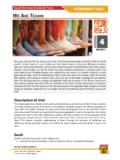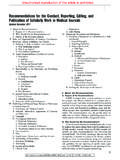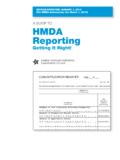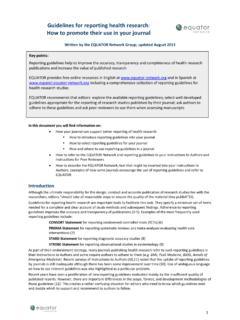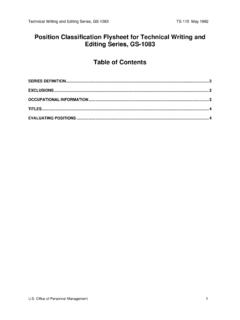Transcription of Reading STAAR, Reporting Category 2) Reading …
1 Texas Performance Standards Project 1 Face to Face with Symmetry and Patterns (Grade 3) 2008 Texas Education Agency TEXAS PERFORMANCE STANDARDS PROJECT Grade 3 Science/Mathematics Unit Mathematics in Nature This guide links the Mathematics in Nature unit to the Texas Essential Knowledge and Skills (TEKS) for third graders. Mathematics in Nature is a science and mathematics unit that allows students to explore and gain knowledge about mathematical patterns found in nature, such as tessellations and the Fibonacci sequence. The unit also has interdisciplinary connections to other subject areas. For example, students will communicate clearly by putting thoughts and feelings into spoken words, as covered in the English Language Arts TEKS. They will also understand the concepts of time and chronology, which the Social Studies TEKS cover. The following document includes the applicable TEKS and the details of the Mathematics in Nature unit.
2 The asterisks indicate the TEKS that are testable on the Texas Assessment of Knowledge and Skills (TAKS). The final section of this document presents the applicable Texas College Readiness Standards adopted by the Texas Higher Education Coordinating Board (THECB) on January 24, 2008. Texas Essential Knowledge and Skills This unit may address the following TEKS: English Language Arts: Uses the relationships between letters and sounds, spelling patterns, and morphological analysis to decode written English Comprehends a variety of texts drawing on useful strategies as needed* (Testable on the Grade 3 Reading staar , Reporting Category 2) Reads grade-level text with fluency and comprehension Understands new vocabulary and uses it when Reading and writing* (Testable on the Grade 3 Reading staar , Reporting Category 1) Analyzes, makes inferences, and draws conclusions about theme and genre in different cultural, historical, and contemporary contexts and provides evidence from the text to support their understanding* (Testable on the Grade 3 Reading staar , Reporting Category 2)
3 Analyzes, makes inferences, and draws conclusions about the author's purpose in cultural, historical, and contemporary contexts and provides evidence from the text to support their understanding* (Testable on the Grade 3 Reading staar , Reporting Category 3) Analyzes, makes inferences, and draws conclusions about expository text and provides evidence from text to support their understanding* (Testable on the Grade 3 Reading staar , Reporting Category 3) Understands how to glean and use information in procedural texts and documents* (Testable on the Grade 3 Reading staar , Reporting Category 3; Testable on the Grade 4 Writing staar , Reporting Category 1, Reporting Category 2, Reporting Category 3) Texas Performance Standards Project 2 Face to Face with Symmetry and Patterns (Grade 3) 2008 Texas Education Agency Uses comprehension skills to analyze how words, images, graphics, and sounds work together in various forms to impact meaning* (Testable on the Grade 3 Reading staar , Reporting Category 2, Reporting Category 3) Uses elements of the writing process (planning, drafting, revising, editing, and publishing) to compose text* (Testable on the Grade 4 Writing staar , Reporting Category 1) Writes expository and procedural or work-related texts to communicate ideas and information to specific audiences for specific purposes* (Testable on the Grade 4 Writing staar , Reporting Category 3)
4 Asks open-ended research questions and develops a plan for answering them Determines, locates, and explores the full range of relevant sources addressing a research question and systematically record the information they gather Uses comprehension skills to listen attentively to others in formal and informal settings Speaks clearly and to the point, using the conventions of language Mathematics: Uses patterns to solve problems* (Testable on the Grade 3 Mathematics staar , Reporting Category 2) Uses lists, tables, and charts to express patterns and relationships* (Testable on the Grade 3 Mathematics staar , Reporting Category 2) Uses formal geometric vocabulary* (Testable on the Grade 3 Mathematics staar , Reporting Category 3) Recognizes congruence and symmetry* (Testable on the Grade 3 Mathematics staar , Reporting Category 3) Selects and uses standard units to describe length, area, capacity/volume, and weight/mass* (Testable on the Grade 3 Mathematics staar , Reporting Category 4) Solves problems by collecting, organizing, displaying, and interpreting sets of data* (Testable on the Grade 3 Mathematics staar , Reporting Category 4)
5 Applies Grade 3 mathematics to solve problems connected to everyday experiences and activities in and outside of school* (Testable on the Grade 3 Mathematics staar ) Communicates about Grade 3 mathematics, using informal language* (Testable on the Grade 3 Mathematics staar ) Uses logical reasoning to make sense of his or her world* (Testable on the Grade 3 Mathematics staar ) Science: Conducts classroom and outdoor investigations following school and home safety procedures and environmentally appropriate practices* (Testable on the Grade 5 Science staar ) Uses scientific inquiry methods during laboratory and outdoor investigations* (Testable on the Grade 5 Science staar ) Knows that information, critical thinking, scientific problem solving, and the contributions of scientists are used in making decisions* (Testable on the Grade 5 Science staar ) Knows how to use a variety of tools and methods to conduct science inquiry* (Testable on the Grade 5 Science staar ) Knows that forces cause change and that energy exists in many forms* (Testable on the Grade 5 Science staar , Reporting Category 2)
6 Knows there are recognizable patterns in the natural world and among objects in the sky* (Testable on the Grade 5 Science staar , Reporting Category 3) Knows that organisms have characteristics that help them survive and can describe patterns, cycles, systems, and relationships within the environments* (Testable on the Grade 5 Science staar , Reporting Category 4) Texas Performance Standards Project 3 Face to Face with Symmetry and Patterns (Grade 3) 2008 Texas Education Agency Knows that organisms undergo similar life processes and have structures that help them survive within their environments* (Testable on the Grade 5 Science staar , Reporting Category 4) Social Studies: Understands the concepts of time and chronology Understands the concepts of location, distance, and direction on maps and globes Applies critical-thinking skills to organize and use information acquired from a variety of valid sources, including electronic technology Communicates in written, oral, and visual forms Uses problem-solving and decision-making skills, working independently and with others, in a variety of settings Description of Unit For this project, students will examine mathematical patterns found in nature, such as tessellations, the Fibonacci sequence, the golden ratio, and pi.
7 For example, the students can create a tessellation jigsaw puzzle. Each student draws a tessellation pattern on a sheet of paper, cuts it out, jumbles up the pieces, and passes the pieces to another classmate for reassembly. In this way, the student looks at tessellations from two different perspectives: once, when constructing his or her own, and from a different perspective when putting together a classmate s tessellation jigsaw puzzle. Similarly, Fibonacci puzzles can be constructed using hexagons as in a beehive, or bricks as in a wall. Examples of these types of puzzles can be found at . A student could make the pieces, write the list of rules for solving the puzzle, and pass the pieces with their rules on to another student for reassembly. Goals Students will meet these goals in their explorations: Ask questions and explore theories Have opportunities to generate new ideas Develop the essential skills of logical thinking, creative problem solving, intellectual risk taking, and communicating Become familiar with various patterns in nature and where they occur Understand the details of how and why such a pattern is constructed and which mathematical concept it illustrates Phase I.
8 Learning Experiences 1. Introduce the concepts of patterns found in nature, such as tessellations, the Fibonacci sequence, the golden ratio, and pi. Talk about where such patterns might be found. Show examples and have students bring other examples. Helpful websites include: 2. As a class, choose a pattern in nature, such as a pine cone, pineapple, turtle shell or starfish, that you all find interesting. Discuss its origin, how it is formed and why, and any special characteristics unique to that pattern. Which mathematical concept does it demonstrate? Texas Performance Standards Project 4 Face to Face with Symmetry and Patterns (Grade 3) 2008 Texas Education Agency 3. Discuss the various types of symmetry. Helpful information can be found at 4. Divide the class into small groups. Each group chooses a pattern and breaks it down into its components.
9 Each group will discuss whether their pattern is symmetrical, how it is formed in nature, examples of the pattern in nature, and which mathematical concept it demonstrates. 5. Each group presents their pattern and their findings to the class. Phase II. Independent Research A. Research process 1. Selecting a topic. Each student should identify a natural pattern for more in-depth study. 2. Asking guiding questions. Once students have selected their pattern, each student should think of three to five guiding questions, such as: Where is this pattern found in nature? What causes it to form that way? What are the pattern's units ( , what does each piece of the pattern look like and how does it function in nature?) Is the pattern symmetrical? Which mathematical concept does the pattern demonstrate? While these examples are general, the student s questions should be specific to the chosen topic.
10 The questions should lead him/her to form individual research-based opinions. The student should also develop a hypothesis or some possible answers to the questions. 3. Designing a research proposal. The student should include numerous components in the research proposal: The type of pattern he/she will study Three to five guiding questions he/she will investigate, as well as hypothetical answers to those questions Resources he/she will need to find answers to questions, such as primary and secondary sources, correspondence with experts on the subject, etc. 4. Conducting the research. After you have approved student proposals, each student begins using the resources he/she has identified and others he/she may encounter. During this stage, the student will need to keep a log, note cards, or resource process sheets of all the sources and what he/she has learned from each one.

